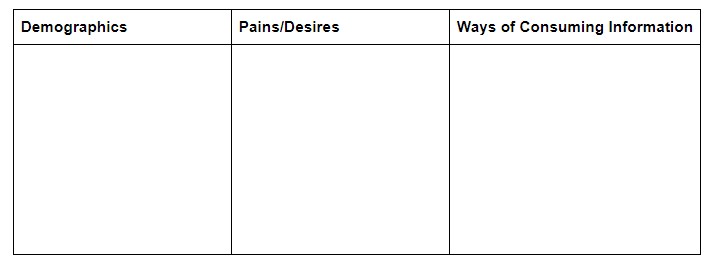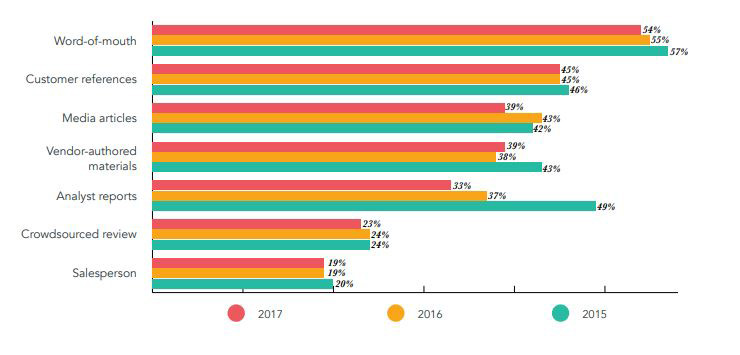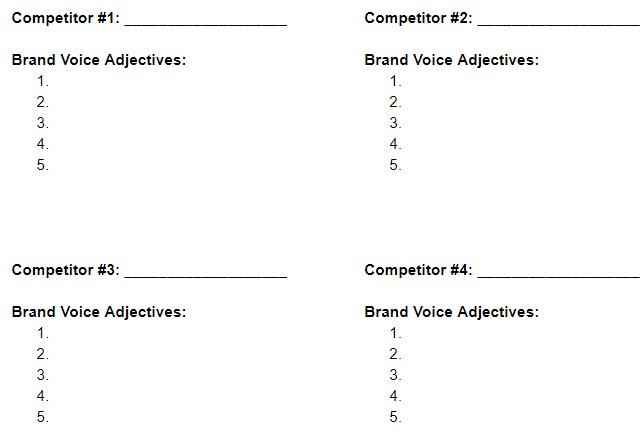Written By:
Tim Stobierski
Your brand voice encapsulates who your company is and how you communicate with your potential customers, clients, or users. This step-by-step guide will teach you how to create an accurate brand voice and focuses on the following key points:
-
More often than not, brand voice is directly inspired by the company’s founder.
-
You need to validate your brand voice by surveying your customers.
-
An accurate brand voice requires a thorough understanding of your buyer.
Think about your favorite brand. It doesn’t matter whether it’s a fashion brand, a tech brand, a food brand, or anything else. Think about the last marketing email you received from them, the last ad of theirs that you saw, the last social posting or blog post. Better yet, pull one (or multiple) of those things up in front of you and read the messaging to yourself, silently, in your head.
How does it sound? Whose voice do you hear? How does the messaging make you feel?

If the brand has a strong, clearly developed brand voice, you’re probably hearing those words in that voice instead of your own. And that’s a powerful thing: It means that that brand has infiltrated your thoughts in a way that can be surprisingly difficult for many businesses, increasing the potential that they can influence you in a way that’s beneficial to their business.
Talk about powerful stuff.
Do you want to learn how to create a strong and brand voice for your company so that you can leverage it to influence your audience and meet your marketing goals? Below, we’ve defined the concept of brand voice, explain why it’s so important, outline the key steps involved in identifying your brand voice, and provide some tips that will help you be successful.
What is brand voice?
Brand voice refers to the unique personality that a company exhibits in their marketing materials and communications. This personality will influence everything from the words and phrases that you use, to the kinds of images and graphics that you create, to the layout of your website, to the general tone of your communications.
One of the best ways to think about brand voice is to literally imagine your company as a person. What would they sound like? What would they look like? How would they dress? How old would they be? In short, what is their personality?
While there’s no single definition for “personality,” it is often understood in terms of the “big five” personality traits, or five key factors:
- Openness to experience: How inventive or curious is your brand? How consistent or cautious is it?
- Conscientiousness: How efficient and organized is your brand? How easy-going or carefree is it?
- Extraversion: How outgoing and energetic is your brand? How solitary or reserved is it?
- Agreeableness: How friendly and compassionate is your brand? How challenging, prone to argument, or detached is it?
- Neuroticism: How sensitive and nervous is your brand? How secure or confident is it?
Understanding these five key factors, while not a requirement for creating a brand voice, can help you conceptualize it and make sure that what you come up with accurately represents your business.
Why is brand voice so important?
Simply put, people do business with companies they like. This means that if you want people to buy your products or services, then you need to make sure that you’re speaking to them in a way they enjoy and matches their expectations.
Your brand voice is one of the basic, primal components of your corporate identity:
- Company Culture
- Company Mission
- Brand Voice
These three components should influence and reinforce each other, and together inform all of your sales, marketing, and customer service policies and practices. Every email, every blog post, every website page, every ad, every social posting, everything should carry a unified and consistent brand voice.
Tailoring your Brand Voice to Buyer Personas
Well-developed buyer personas can have a huge impact on your inbound marketing strategy and assist in creating the most appealing messages to your target audience. That’s because these semi-fictional representations of your ideal customers are based on market research and data about existing customers.
Your brand voice should align with your buyer persona and their overall customer profile. When it comes to determining which factors are most important to a buyer profile, list out the details of these elements in a format like this:

How to Define Your Brand Voice
If you’re ready to start defining your company’s brand voice, we typically recommend that you follow the steps below. You can also download our Brand Voice Worksheet, which will help you frame your discussion and organize your thoughts.
1. Conduct an initial brainstorm.
In our opinion, a company’s brand voice should closely reflect the voice and characteristics of the company’s founders. That’s why Apple’s brand voice is Steve Jobs. It’s why Disney’s brand voice is Walt Disney. There’s simply no surer way to build authenticity directly into your brand than to channel your founder’s voice.
If you’re responsible for developing your company’s brand voice, we recommend that you bring together three or four people who work very closely with the founder of the company (or, if these people are inaccessible, people who have the closest ties to the company mission).
Once this group is formed, you’re going to ask everyone to think of 15-20 adjectives, qualities, or attributes that describe the founder of the company. Define that person’s traits and personality. Then, circle the qualities that everyone agrees with, and use those basic qualities to form the bedrock of your brand voice.
Some specific components you should think about during this brainstorm include:
Your Company Culture
Brands that engender trust in their customers and potential customers are more likely to close sales, earn new business, and retain existing business, especially when compared against brands seen as inherently untrustworthy.
But according to HubSpot’s 2017 State of Inbound Report, consumers don’t really trust brands. Vendor-authored materials (that is, material created by brands trying to sell) rank pretty low in terms of trust, and that salespeople themselves top the bottom of the chart, with just 19 percent of respondents saying that they find salespeople trustworthy.

Unfortunately, an individual marketer isn’t likely to have a direct impact on how society at large views the trustworthiness of business or brands in general. For that to happen, a pretty big shift is going to need to take place across all levels of business and society and, let’s be real here, that isn’t likely to be resolved any time soon.
But individual marketers can have a direct impact on whether or not potential customers find your particular brand trustworthy. All it takes to engender trust in your brand is to ensure that your brand is, well, trustworthy.
You can expedite this process by:
1. Creating Valuable Content
2. Backing Up Your Claims
3. Don’t Play Games
4. Showing that You’re Human
5. Don’t Forget About Your Existing Customers
Also, take time to collaborate with your coworkers to describe your company’s culture in 10-12 adjectives. Of those, identify at least 6 attributes most valuable to your customer and then list out 3-5 qualities that you want your brand voice to embody.
Your Tone
Your tone—how formal your writing is—should be based in equal parts off of your buyer profile and your company culture.
Your buyer profile because, well, you need to appeal to your ideal buyer, and a part of that means speaking to them in the way that they want to and expect to be spoken to. And your company culture because it’s really hard trying to sound like something you’re not.
The easiest way to do this is to establish a spectrum from 1 to 10. On one end of the spectrum, imagine the tone and formality of a publication like The New York Times, and on the other end think of someone like Buzzfeed. In the middle you might find someone like Pepperland.

Now, where along this spectrum would you like your tone to fall?
Your Competitors’ Voice
One of the most important roles that brand voice plays is helping you stand out from the competition.
The key is to define a brand voice that stands out from your competition, but still aligns with your message. Without that differentiator, customers will have difficulty telling your product apart, or understanding why they should be buying from you vs. your competitor. In cases like this, so long as your brand voice is different from your competitors, that can become the differentiator that customers need.
A good practice is to evaluate your main competitors and identify at least 5 adjectives that best describe their brand voice. Your list should resemble something like this:

This list will help you answer important questions, such as: What are some common themes with your competitors? Is their content dry or boring? Are their voices stiff or corporate?
If you can identify the similarities, by going in a different direction you can craft your own brand voice in a way that helps your company stand out.
2. Validate your conclusions with a larger group.
Once you’ve written up your brand voice based on the conclusions above, you need to validate your conclusions with the broader company. Your goal in this phase is to ensure that everyone is in agreement and aligned. If there is any disagreement, you should discuss it and determine whether or not the brand voice needs to be adjusted.
This is also the phase where you will need to get final signoff and approval from any key stakeholders, like department managers, directors, and even the CEO themself. Because brand voice will influence all customer-facing policies and activities, you want to be sure that the Powers That Be agree with your conclusions.
3. Survey your customers.
After you’ve fleshed out your brand voice and validated it internally, it’s critical that you take those initial conclusions and validate them with your customers. Otherwise, it’s possible that the voice you settle on internally is not actually a voice that speaks to the concerns or viewpoints that are most important to your buyers.
For this step, we recommend that you identify a small group of loyal customers and survey them. Ask them:
- Which of the following attributes do you like most?
- Which are the most important to you?
- Which do you like the least?
- Which are the least important to you?
- If you were to describe our company’s voice, how would you do so?
Hopefully, you’ll find that your customers agree with the conclusions you’ve drawn. If you find that this is not the case, it will be important for you to revisit your voice and adjust it accordingly. Or, it may be time to re-evaluate and understand your ideal buyer.
Implement your Voice into Editorial Guidelines for Consistency
It’s important to use the insights you’ve gathered to create a set of editorial guidelines, written in your desired brand voice, which you should then share with your entire team.
The clearer you can get in helping your team understand and implement your brand voice, the better.
Matching your editorial guidelines and mission statement can help streamline your brand voice, which creates brand consistency for customers, clients, and prospects.
Brand Voice is Critical to Business Success
Without a clear and easily recognizable brand voice that speaks to the value you bring your customers, it will be incredibly difficult—if not impossible—for you to build the relationships and connections required for long-term business success. At its worst, this might mean that your marketing materials damage customer trust; that your sales processes push leads away; and that your customer service policies fail to retain customers.
Are you unsure of whether or not you’re capable of defining your company’s brand voice? Download our Brand Voice Worksheet to get started, or reach out to see how we can help.







